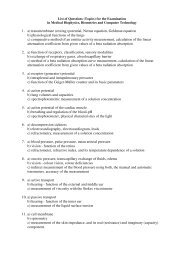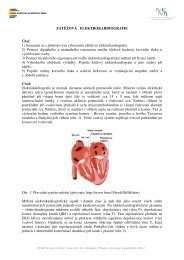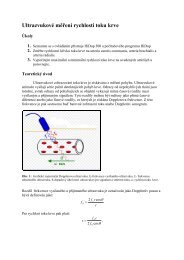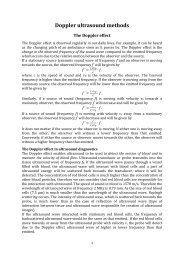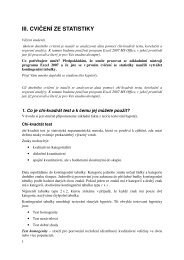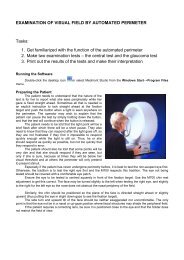Sound and its properties Human voice Biophysics of hearing Sound
Sound and its properties Human voice Biophysics of hearing Sound
Sound and its properties Human voice Biophysics of hearing Sound
- No tags were found...
Create successful ePaper yourself
Turn your PDF publications into a flip-book with our unique Google optimized e-Paper software.
Voice <strong>and</strong> Speech<strong>Human</strong> <strong>voice</strong> is specifically that part <strong>of</strong> human sound production in which the vocalfolds (vocal cords) are the primary sound source. Generally speaking, themechanism for generating the human <strong>voice</strong> can be subdivided into three parts; thelungs, the vocal folds within the larynx, <strong>and</strong> the articulators. The lung (the pump)must produce adequate airflow <strong>and</strong> air pressure to vibrate vocal foldsAdult men <strong>and</strong> women have different vocal folds sizes; reflecting the male-femaledifferences in larynx size. Adult male <strong>voice</strong>s are usually lower-pitched <strong>and</strong> havelarger folds.http://www.youtube.com/watch?v=ajbcJiYhFKYVocal rangeThe <strong>voice</strong>d speech <strong>of</strong> a typical adult male has a fundamental frequency from about90 to 170 Hz, <strong>and</strong> that <strong>of</strong> a typical adult female from 170 to 260 Hz
Intensity <strong>of</strong> sound wavehas been defined as the energy which passes through a unit areaperpendicular to the direction <strong>of</strong> propagation per unit time.Its derived SI un<strong>its</strong> are therefore joules per square meter per second (J m -2 s -1 ),or watts per square meter (W m -2 ).When we study the human ear - this is a rather cumbersome unit, because wecan hear sound intensities over an enormous range, from something <strong>of</strong> the order<strong>of</strong> 1 x 10 -12 W m -2 to something in excess <strong>of</strong> 1 W m -2 . For convenience, soundintensity is <strong>of</strong>ten expressed in terms <strong>of</strong> a unit called the decibel (dB).Intensity level (<strong>Sound</strong> pressure level) in dB =10logII0• The decibel is actually a measure <strong>of</strong> the relative intensity <strong>of</strong> the soundcompared with a reference intensity.• The reference intensity is taken as I 0= 1 x 10 -12 W m -2 , which is the lowestintensity sound (<strong>of</strong> frequency 1 kHz) that the average human can hear.Loudness, a subjective measure, is <strong>of</strong>ten confused with objective measures <strong>of</strong>sound strength such as sound pressure, sound pressure level (in decibels), soundintensity or sound power.Un<strong>its</strong> used to measure loudness:Sone (loudness N)Phon (loudness level L) ((loudness level = intensity level i.e. 1dB = 1 Phon only for 1 kHz tone))The sensitivity <strong>of</strong> the human ear changes as a function <strong>of</strong> frequency.Each line on this graph shows the SPL required for frequencies to be perceived as equallyloud. It also shows that humans with good <strong>hearing</strong> are most sensitive to sounds around 2–4kHz, with sensitivity declining to either side <strong>of</strong> this region.
Acoustic impedanceAcoustic impedance Z <strong>of</strong> a medium, such as air, rock or water is a materialproperty. It determines the size <strong>of</strong> reflection <strong>of</strong> the acoustic energy on a boundarywith different acoustic impedance.Z = ρ c [kgs -1 m -2 ], [Nsm -3 ]I =p 22 Zρ 1c 1reflection coefficient:R =( Z ) 22 − Z1( Z + Z ) 221ρ 2c 2Relationship between intensity level, intensity <strong>and</strong> pressure <strong>of</strong> a sound waveAverage intensity level(dB)160140120100806040200Average intensity(Wm-2)1x10 41x10 21x10 01x10 -21x10 -41x10 -61x10 -81x10 -101x10 -12Average pressure(Pa)20002002020.20.020.0020.00020.00002Thus a sound at a level <strong>of</strong> 120 dB, which will cause physical discomfort, has amean pressure amplitude is about 20 Pa, or approximately 0.02% <strong>of</strong> 1 atm. Themean pressure amplitude generated by someone whispering in your ear (20 dB) isnot much more than one billionth <strong>of</strong> an atmosphere.
Anatomy <strong>and</strong> physiology <strong>of</strong> the earThe ear serves as a transducer, converting the mechanical energy <strong>of</strong> the incomingsound wave into electrical energy for onward transmission to the brain.Anatomy <strong>of</strong> the ear. This diagramis not to scale; the middle- <strong>and</strong>inner-ear structures have beenenlarged for clarity.The pressure fluctuations associated with the incoming sound waves are rathersmall, <strong>and</strong> that an amplification device is needed if sounds at our lowest threshold<strong>of</strong> intensity are to be heard.Furthermore, the inner ear is filled with fluid, <strong>and</strong> the fluid has a rather differentimpedance to that <strong>of</strong> the air through which the incoming sound wave arrives. Thiswould mean that a large proportion <strong>of</strong> the energy <strong>of</strong> the incoming sound wave wouldsimply be reflected back from the interface.The middle ear serves both to amplify the incoming sound pressures <strong>and</strong> tomatch the impedance <strong>of</strong> the inner <strong>and</strong> outer ear structures.The outer ear is primarily a collecting <strong>and</strong> funnelling device, although <strong>its</strong>physical characteristics do give rise to a particularly efficient response to soundwaves with frequencies <strong>of</strong> around 3-4 kHz.
Outer earconsists <strong>of</strong> the pinna <strong>and</strong> the ear canal.The pinna (external auricle) <strong>of</strong> the human serves little useful purpose — apart frombeing somewhere to hang the spectacles <strong>and</strong> miscellaneous decorative devices.The ear canal (auditory canal, external canal) is roughly the shape <strong>of</strong> a tube,approximately 30 mm in length <strong>and</strong> 6 mm in diameter. The air in a tube willresonate at particular frequencies determined by the length <strong>of</strong> the tube <strong>and</strong> by theboundary conditions at the ends <strong>of</strong> the tube. The ear canal is closed at one end, bythe eardrum, <strong>and</strong> open at the other.St<strong>and</strong>ing waves in a tube open at one end occur at frequencies given byf n= (2n-1)v4ln=1,2,3,…Assuming the velocity <strong>of</strong> sound in ambient air to be 340 m s-1, the fundamentalfrequency <strong>of</strong> the ear canal is approximately 2.8 kHz.The human ear is most sensitive to sounds at about this frequency.The eardrum (tympanic membrane, tympanum) forms the boundary between theouter ear <strong>and</strong> the middle ear. It vibrates in response to incoming sound waves, <strong>and</strong>transm<strong>its</strong> the vibrations into the small bones in the middle ear. It is a thin membrane<strong>of</strong> tissue, approximately 0.1 mm thick, with a cross-sectional area <strong>of</strong> about 60 mm 2 .It can be damaged (ruptured or perforated) by sounds <strong>of</strong> high intensity, above about160dB, but in common with other tissues, it does have the capacity to heal over aperiod <strong>of</strong> time.Middle earThe middle ear is an air-filled cavity in the temporal bone <strong>of</strong> the skull. Its outerboundary is the eardrum <strong>and</strong> <strong>its</strong> inner boundaries are the oval window <strong>and</strong> the roundwindow at the entrance to the cochlea. The cavity <strong>of</strong> the middle ear has an air vent tothe pharynx through the Eustachian tube. The purpose <strong>of</strong> this venting is to equalizethe air pressures on either side <strong>of</strong> the eardrum.The primary mechanical components <strong>of</strong> the middle ear are the ossicles (smallbones). They are the hammer (malleus), the anvil (incus) <strong>and</strong> the stirrup (stapes).
The function <strong>of</strong> the middle ear is to amplify the pressures from the incoming soundwaves <strong>and</strong> to match the impedances <strong>of</strong> the air-filled ear canal <strong>and</strong> the fluid-filledcochlea.The lever system provided by the ossicles increases the force at the oval windowrelative to that at the eardrum.It works as an impedance-matching system, the purpose <strong>of</strong> which is to maximize the transfer<strong>of</strong> power from the air in the ear canal, which is light <strong>and</strong> compliant, to the fluid in the inner ear,which is heavy <strong>and</strong> stiff.If it were not for the impedance-matching system, much <strong>of</strong> the energy <strong>of</strong> the sound wavewould simply be reflected back out <strong>of</strong> the ear.The middle ear is capable <strong>of</strong> producing a reasonable match <strong>of</strong> the impedances <strong>of</strong> the inner <strong>and</strong>outer ear over a range <strong>of</strong> frequencies from about 400 Hz to about 4000 Hz.The primary mechanism that the middle ear uses for impedance matching is amechanical pressure amplification system. The lever arm from the fulcrum to thecentre <strong>of</strong> the eardrum is greater than that to the oval window by about 30%, <strong>and</strong> sothe force is increased by 30%. Furthermore, the oval window has a cross-sectionalarea <strong>of</strong> only about 3 mm 2 , compared with the effective cross-sectional area <strong>of</strong> the <strong>of</strong>eardrum <strong>of</strong> approximately 60 mm 2 . The anticipated pressure amplification thatmight be achieved by the is therefore1.3 x 60/3Typical pressure amplifications measured experimentally are around 17.
Inner earis a multi-chambered cavity in thetemporal bone.consists <strong>of</strong> several parts,including the cochlea, thesaccule, the utricle <strong>and</strong> the semicircularcanals.the function <strong>of</strong> the utricle <strong>and</strong>semi-circular canals is associatedwith our senses <strong>of</strong> position <strong>and</strong>balance.Only the cochlea has a role inthe <strong>hearing</strong> process. The role <strong>of</strong>the cochlea is to convert themechanical energy presentedas a mechanical vibration at theoval window into electricalenergy, transmitted onwardsthrough the auditory nerve.The cochlea is essentially a tapered tube approximately 30 mm in length. The tubeis not straight but is wound into a spiral shape, so that <strong>its</strong> external appearance ismuch like the shell <strong>of</strong> a snail.The diameter <strong>of</strong> the tube tapers downwards from the outside <strong>of</strong> the spiral, at theinterface to the middle ear, to the apex.The tube is divided along <strong>its</strong> length info three chambers. The two outerchambers, the scala vestibuli <strong>and</strong> the scala tympani, are connected at the apex<strong>of</strong> the cochlea through an opening called the helicotrema.The fluid in the scalae is called perilymph. The vibration <strong>of</strong> the oval window,induced by the stirrup, gives rise to a wave traveling inwards away from theoval window. The outer boundaries <strong>of</strong> the cochlea are rigid, <strong>and</strong>, since the fluid isbasically incompressible, some flexibility is required to allow the system to moveunder the applied loads. This flexibility is provided by the round window at the outerboundary <strong>of</strong> the scala tympani. The cochlear duct, s<strong>and</strong>wiched between the twoscalae, contains a fluid called endolymph.
The membrane separating the scala tympani from the cochlear duct is calledthe basilar membrane, <strong>and</strong> <strong>its</strong> motion plays a role in the generation <strong>of</strong> thenerve impulses. The membrane contains many fibres, each approximalely 1—2µm in diameter, the length <strong>of</strong> these fibers varies from approximately 75 µm near tothe oval window up to about 475 µm at the helicotrema. On the basilar membraneis the organ <strong>of</strong> Corti that accomplishes the transformation <strong>of</strong> mechanical toelectrical energy.The organ <strong>of</strong> Corti containshair cells, rooted on thebasilar membrane, which areconnected to nerve fibres.These cells have projectinghairs or fibers that bridgeacross to the tectorialmembrane. The hairs areapproximately 8-12 µm indiameter. As the basilarmembrane moves in responseto the pressure waves, it bendsor shears the hairs <strong>and</strong> thesestimulate the nerve cells toproduce electrical impulses.Vibrations <strong>of</strong> stapes <strong>and</strong> oval window displace perilymph fluid within scala vestibuli.Vibrations pass to the scala tympani. Movements <strong>of</strong> perilymph travel to the base <strong>of</strong> cochleawhere they displace the round windowperilymphscala vestibuliscala tympanyperilymphendolymphTheories <strong>of</strong> <strong>hearing</strong>there is still no wholly satisfactory model to explore the transformer mechanism <strong>of</strong><strong>hearing</strong> to analyse intensity <strong>and</strong> frequency <strong>of</strong> the sound.Place theoriesA] Helmholtz’s resonator theorythe fibers in the basilar membrane vary in length, being shorter near the ovalwindow <strong>and</strong> longer near the apex. A comparison can be made between this array<strong>of</strong> fibers <strong>and</strong> the wires in a harp or piano.Assuming that the fibers are all in tension, then each fiber has a resonantfrequency that can be calculated from the laws <strong>of</strong> mechanics.Only certain fiber corresponding to certain input vibration frequency will resonate.However the theory does not explain the total frequency range <strong>of</strong> human <strong>hearing</strong>.
B] von Bakesy’s theoryMOTION OF THE BASILAR MEMBRANEthe cochlea is a criticallydamped mechanical system,<strong>and</strong> the motion <strong>of</strong> the basilarmembrane is in the form <strong>of</strong> awave moving away from theoval window.The amplitude <strong>of</strong> vibration<strong>of</strong> the basilar membranevaries along <strong>its</strong> length, <strong>and</strong>the position <strong>of</strong> maximumamplitude is a function <strong>of</strong>frequency. At low frequencies(25 Hz), the whole <strong>of</strong> themembrane is vibrating, <strong>and</strong>the peak amplitude <strong>of</strong> vibrationis at the far end, near thehelicotrema. At highfrequencies (3 kHz), the peakamplitude <strong>of</strong> vibration occursnear to the oval window. B] von Bakesy’s theory
Organ <strong>of</strong> Corti• Stereocilia <strong>of</strong> the outer hair cellsare embedded in the tectorialmembrane.• When the cochlear duct isdisplaced, a s<strong>hearing</strong> force iscreated, moving <strong>and</strong> bending thestereocilia.• Ion channels open, depolarizingthe hair cells, releasingglutamate that stimulates thesensory neuron.• Greater bending <strong>of</strong> stereocilia, theincreased frequency <strong>of</strong> APproduced.Auditory Hair Cells• Two types <strong>of</strong> hair cells are located within the human organ <strong>of</strong> Corti– Inner hair cells (approximately 3500) form a single line <strong>of</strong> cells along the basilarmembrane = primary sensors– Outer hair cells (approximately 12,000) are arranged in three rows along thebasilar membrane = amplifiersCilia project from the top <strong>of</strong> each haircellThe tectorial membrane isattached to the hair cell ciliaWhen sound waves move thebasilar <strong>and</strong> tectorialmembranes, the cilia bend inone direction or the otherShear <strong>of</strong> the cilia generates areceptor potential that releasesa neurotransmitter
Hearing deficiencynormal audiogram<strong>hearing</strong> impairment <strong>of</strong> the conductive typedB6040200-20Air conductionBone conduction60 250 1000 4000Hz<strong>hearing</strong> impairment <strong>of</strong> the sensorineural typeaffects the air <strong>and</strong> bone conduction by the same amplitudedB6040200-20Air conductionBone conduction60 250 1000 4000Hz6040dB200-20Air conductionBone conduction60 250 1000 4000HzQuantification <strong>of</strong> <strong>hearing</strong> lossMild:for adults: between 25 <strong>and</strong> 40 dBfor children: between 20 <strong>and</strong> 40 dBModerate: between 41 <strong>and</strong> 55 dBModerately severe: between 56 <strong>and</strong> 70 dBSevere: between 71 <strong>and</strong> 90 dBPr<strong>of</strong>ound: 90 dB or greaterHearing deficiencyPresbycusis is a progressive <strong>hearing</strong> impairment accompanying age, typicallyaffecting sensitivity to higher frequencies (above about 2 kHz).Tinnitus is the perception <strong>of</strong> sound within the human ear in the absence <strong>of</strong>corresponding external sound.Tinnitus is not a disease; but a symptom resulting from a range <strong>of</strong> underlyingcauses that can include: ear infections, foreign objects or wax in the ear, noseallergies that prevent (or induce) fluid drain <strong>and</strong> cause wax build-up. Tinnitus canalso be caused by natural <strong>hearing</strong> impairment (as in aging), as a side-effect <strong>of</strong> somemedications, <strong>and</strong> as a side-effect <strong>of</strong> genetic (congenital) <strong>hearing</strong> loss. However, themost common cause for tinnitus is noise-induced <strong>hearing</strong> loss.As tinnitus is usually a subjective phenomenon, it is difficult to measure usingobjective tests, about one in five people between 55 <strong>and</strong> 65 years old report tinnitussymptoms .
Correction <strong>of</strong> <strong>hearing</strong> lossesHearing implant is composed <strong>of</strong> a sensitive microphone, a miniature transistor amplifier, a powersource <strong>and</strong> a suitably adjusted loudspeaker system. This can have the shape <strong>of</strong> a small earphone with ahollow top which is put into the outer auditory duct. In most cases are only amplify those frequencyranges, which are heard worse.For non-<strong>hearing</strong> patients with preserved auditory nerve function there is hope for at least partialrenewal <strong>of</strong> <strong>hearing</strong> through electrode cochlear implant. A multielectrode system stimulates the auditorynerve at various places <strong>of</strong> the cochlea <strong>and</strong> partially replaces the function <strong>of</strong> Corti organ. The device iscomposed <strong>of</strong> an outer part <strong>and</strong> inner (implanted) part. The outer part is created by a special sensitivemicrophone with amplifier, speech processor which modulates the acoustic signal <strong>and</strong> the emitting coil.The implanted part is composed <strong>of</strong> a receiving coil, a demodulator <strong>and</strong> a multielectrode system. Thereceiving coil with the demodulator is implanted under the skin behind the auricle, the electrodesystem is introduced into middle part <strong>of</strong> the cochlea, the ductus cochlearisMain components <strong>of</strong> a cochlear implant (M microphone, SP speech processor, EC emitting coil,RC receiving coil, D demodulator, SE system <strong>of</strong> electrodes.http://www.youtube.com/watch?v=-WA7-k_UcWY





